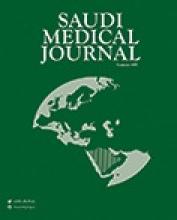SYSTEMATIC REVIEW
Circulating rotavirus G and P strains post rotavirus vaccination in Eastern Mediterranean Region
Almalki et al conclude that rotavirus circulating strain prevalence in Eastern Mediterranean Region (EMR) countries has changed post vaccination, and G9P[8], G2P[4], and G9P[4] have become more dominant. Proportion of rotavirus strains in these countries after vaccination has significantly reduced. There is an increase in circulating strain G2P[4] in the post-vaccination period, which needs further monitoring. Thirty pre-vaccination studies reported frequent rotavirus strains among children below 5 years of age. G1P[8] has been identified as the most dominant type prior to vaccination in EMR countries. Five post-vaccination studies conducted in 3 countries (Saudi Arabia, Morocco, and Yemen) illustrated that G1P[8] is the most prevalent strain in Saudi Arabia. In Yemen, G1P[4] is the most prevalent strain, followed by G9P[8] and G1P[8]. In Morocco, G1P[8] was not reported 3 years post vaccination; however, incidence of G9P[8] was reported at 67% and G2P[4] at 33%.
see page 755
The circulating Rotavirus strains prior and post vaccination in Saudi Arabia, Morocco and Yemen.
ORIGINAL ARTICLES
Efficacy and safety of endoscopic dilatation in the management of esophageal strictures in children
Al Sarkhy et al determine the outcomes of endoscopic dilatation of esophageal strictures in children. Forty-three children with esophageal strictures were identified. Tracheoesophageal fistula, gastroesophageal reflux disease and eosinophilic esophagitis were the leading causes of esophageal strictures. Forty-three patients underwent 180 dilatation sessions; the median number of dilatation sessions per patient was 3 (range, 1-48), and the median interval between sessions was 8 weeks (range, 1-24 weeks). Among 180 dilatation sessions,1.7% events of esophageal perforation were observed. The outcomes varied depending on the primary cause of the stricture; complete response was achieved the best in eosinophilic esophagitis-related strictures, followed by anastomotic strictures post tracheoesophageal fistula repair and gastroesophageal reflux disease-related strictures.
see page 787
Endoscopic balloon dilatation of an esophageal stricture showing the balloon positioned endoscopically through the stricture.
The association between the prevalence of restless leg syndrome, fatigue, and sleep quality in patients undergoing hemodialysis
Turk et al determine the prevalence of restless legs syndrome (RLS) in patients with chronic renal failure (CRF) and to compare CRF patients with or without RLS in terms fatigue and sleep quality. Of all the participants, 16.8% (Group 1) were found to have RLS, while 183 patients had no RLS (Group 2). The mean ages were similar between groups. With respect to laboratory analyses, a p-value of <0.05 was considered in Group 1 than in Group 2. Restless legs syndrome was mild (7.1%), moderate (46.4%) and severe (39.3%) in patients with RLS. Factors associated with the severity of RLS included weight, duration of dialysis, anuria, iron, total iron binding capacity, calcium and transferrin saturation. The PSQI and FSS scores were significantly worse in Group 1 (p<0.001). They conclude that RLS is a common condition in patients undergoing hemodialysis; the results of our study confirm the adverse effects of RLS in terms of many aspects of sleep quality and fatigue.
see page 792
CASE REPORT
Bilateral adrenal hemorrhage in antiphospholipid syndrome. Anticoagulation for the treatment of hemorrhage
Aldaajani et al present a 43-year-old male with Hashimoto’s thyroiditis, right leg deep-vein thrombosis, right lower segmental and sub-segmental pulmonary embolism (PE) treated with warfarin for 6 months, who had no known significant family history of medical diseases. Presented to the emergency room (ER) with right flank pain, nausea, and vomiting for 5 days, along with dizziness, blurring of vision, and disorientation. In the ER, he was observed by the surgical team. All diagnostic exams were inconclusive of acute (surgical) abdominal disease. He was found to be confused and hypertensive (blood pressure, 164/94 mmHg). Abdominal examination revealed generalized distention and tenderness. Laboratory tests showed lymphopenia, thrombocytopenia, and hypoosmolar hyponatremia. Three percent normal saline was administered over 4 hours, and brain CT revealed normal findings.
see page 829
Selected single axial cut from abdominal computed tomography examination with direct intravenous contrast administration displays that both adrenal glands are enlarged, with reduction of their contrast enhancement, together with surrounding retroperitoneal fat stranding; however, they both show preserved configuration.
- Copyright: © Saudi Medical Journal
This is an open-access article distributed under the terms of the Creative Commons Attribution-Noncommercial-Share Alike 3.0 Unported, which permits unrestricted use, distribution, and reproduction in any medium, provided the original work is properly cited.









